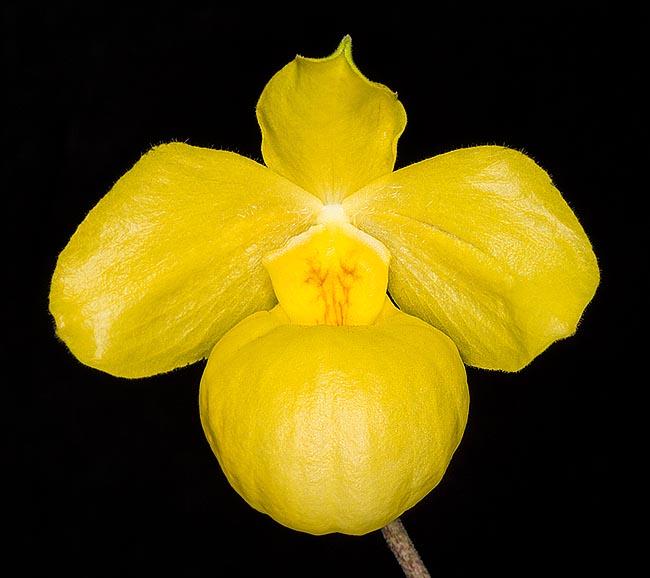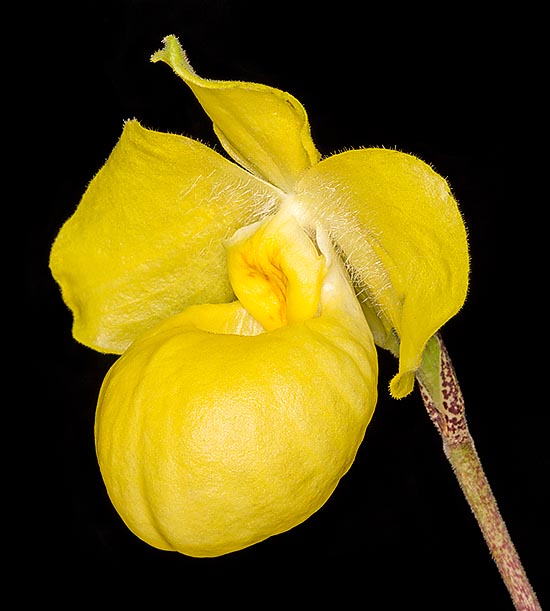Family : Orchidaceae

Text © Pietro Puccio

English translation by Mario Beltramini

Paphiopedilum armeniacum, at home in China and Myanmar, was discovered only in 1979 © Giuseppe Mazza
The name of the genus is the combination of the Greek terms “Παφια” (paphia), attribute of Aphrodite, and “πεδιλον” (pedilon) = sandal, with reference to the shape of the labellum.
The name of the species refers to the colour of the flowers of the first specimen described which should recall that of the fruits of the apricot, the Prunus armeniaca L. (1753)
Common names: golden slipper orchid (English).
The Paphiopedilum armeniacum S.C.Chen & F.Y.Liu (1982) is a terrestrial or lithophytic species with thin long creeping rhizome and spaced tufts, up to 10-15 cm, formed by 5-7 oblong-linear leaves, 6-12 cm long and 2-2,5 cm broad, distichous, coriaceous, with apex usually pointed and margin finely serrated, densely speckled of dark purple below, spotted of light green and dark green above. Terminal floral scape, erect, carrying usually one single flower, rarely two, of 6-10 cm of diameter, pale yellow to apricot yellow with red venations on the staminode and purple spots inside the labellum; 13-28 cm long peduncle, greenish yellow speckled of purple and green pedicel and ovary, 3-3,5 cm long.
Dorsal ovate sepal with pointed apex and finely ciliated margins, pubescent at the base, 2-4,8 cm long and 1,5-2,2 cm broad, lateral sepals merged to form one unique sepal (synsepalous) behind the labellum, similar as shape to the dorsal, 2-3,5 cm long and 1,2-2 cm broad, ovate-elliptic to orbicular petals, 3-5,5 cm long and 2-5 cm broad, with slightly undulated and ciliated margins, saccate labellum, 4-5 cm long and 3-4,5 cm broad, with involute upper margin and staminode almost ovate of 1-2 cm of diametre.

It's nowadays at risk of extinction due to the enormous market demand © Giuseppe Mazza
Discovered in 1979, this species immediately aroused such an interest, due to the particular colour of the flowers and the ornamental foliage, to be at once object of an extensive collection that has quickly rarefied its presence in nature.
It requires high diffused luminosity and medium temperatures in summer, 18-25 °C, with high humidity, 75-85%, cooler ones in winter, 12-14 °C, with lowest night values preferably not under the 5 °C; it is fundamental, in all seasons, good and constant ventilation. Preferably cultivable in wide pots and baskets, to allow the rhizomes to expand freely, with particularly aerated and draining substratum which may be formed by medium sliced bark with agri-perlite and fragments of charcoal and possible sphagnum, for maintaining a bigger humidity, if the ambient is rather dry.
The waterings must be regular and abundant in summer, preferably in the first hours of the day thus to allow the water to dry up for avoiding stagnations at the axil of the leaves which may cause rottenness, spaced in winter, but without allowing the substratum to dry up completely. The waterings and nebulisations are to be done with rainwater, from reverse osmosis or demineralised, and the fertilizations, during the vegetative period, with hydrosoluble balanced products, with microelements, at ¼ of the dosage suggested on the package, distributed and alternated in way to avoid salts accumulation at the roots. The repottings are to be done by the end of the blooming.
The species is reported in the appendix I of the CITES (endangered species whose trade is allowed only in exceptional circumstances) and is inserted in the red list of the International Union for Conservation of Nature (IUCN) of the plants at very high risk of extinction in nature in the forthcoming future (“endangered”).
Synonyms: Paphiopedilum armeniacum var. markii O.Gruss (1997); Paphiopedilum armeniacum f. markii (O.Gruss) Braem (1998); Paphiopedilum armeniacum var. parviflorum Z.J.Liu & J.Yong Zhang (2001); Paphiopedilum armeniacum var. undulatum Z.J.Liu & J.Yong Zhang (2001).
→ For general notions about ORCHIDACEAE please click here.
